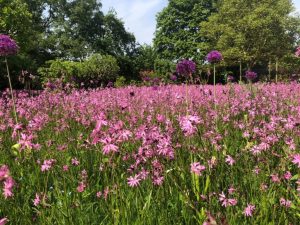Hope you’re all well. Autumn is well and truly here and although I lament the end of long summer days (and goodness I do), I remember each year how beautiful autumn is. There is something so very rewarding about collecting leaves and tidying borders , making mulch for the future. A walk through an autumnal woodland is definitely one of my favourite things to do.
As with all our gardens it’s the time of year where we take stock and plan for the next 12 months. One of the areas which comes up for discussion each year are the wildflower areas we are creating. Over the last 10 years or so we have been making wildflower meadows for some of our clients. It certainly is a fabulous way to develop a different aspect to a garden and will increase biodiversity.
We have gone about this process in numerous ways, at different costs, length of time, with differing outcomes and different expectations from clients. I thought I would share some of our experiences.
Below are the different ways we have created wildflower gardens, how they have progressed through the years and some of the pros and cons associated with each process.
Wildflower Turf.

Pros: The most instant way of creating a wildflower meadow. Choose a turf with a mix of flowers which suits the soil conditions and which the client likes. The turf comes with only two grasses with are noninvasive and a mixture of native annuals and perennials, both of which will flower in the coming summer unlike seed mixes. Prepare the ground, lay the turf in autumn, winter or early spring and watch it grow and flower. In its first year this method can be total exquisite. We have added bulbs prior to planting, camassia, the odd tulip, allium and narcissus. The photograph below shows turf in its first late spring.
Cons: We have to spray off the existing grass with herbicide, this may need to be applied several times. The area then requires cultivating and levelling taking up many hours of labour.
The mix of plants you or your client may have initially chosen will change with time depending on which annuals seed and germinate the following year and as the perennials get more established. With the example above the fabulous red campion seen here completely disappeared the next spring. and oxeye daisies predominated. A long dry summer and hard ground in autumn prevented the seed ripening and germinating the next spring. The following autumn we purchased an annual seed mix but we never achieved the same look again. This is by far the most expensive way to achieve a wildflower meadow and I have to say although instantly magnificent for the first summer, our clients have then been disappointed in following years. As horticulturalists we have tried to explain that as with all aspects of gardening, nothing stays the same, but a client who has spent in some cases many thousands of pounds finds it more difficult to understand and have been resistant to purchasing more seed each year.
Finally, the turf comes on plastic netting to keep the plants and rolls together, this is a contradiction to often the reasons to create an area of wildflowers, we hear about adding biodiversity to the garden, sustainable, less management required, but here we are adding a plastic netting to large areas of the garden.
Complete removal of existing vegetation and then seeding and/or planting plugs.
Pros: We have had mixed results using this method and I would say more cons than pros, so what are the pros? We can have complete governance over the plants chosen. The choice can be made based on the soil conditions and plants suitable to the area. No plastic netting!
Cons: We still are required to spray off the existing grass with herbicide and as above this may take several applications. Most wildflower seed mixes will have a balance of annuals, perennials and noninvasive grass species. Depending on environmental conditions once the seed has been sown, germination rates can be very variable. Clients will also need to understand that the perennials will not flower until the following summer, say some 18 months after seed has been sown. Again there is the issue of which annuals will also seed the following year and over seeding is often required. Although much cheaper than turf, the perception by clients is that wildflower seed is not cheap. Often we have a conversation that yes it may be costing several hundred pounds but there are potentially 1000s of plants. Similarly with plugs we have had mixed results. These little plants can be at times temperamental and establishment is inconsistent. This method is slower than the turf taking some 2-3 years to establish. Again we use a selection of ‘naturalistic’ bulb planting to extend the season and give a little more colour.
Managing and adding to the existing wildflowers and grassland, naturalising.
Pros: No herbicide or plastics used! This is a ‘slow movement’ way to establish a wildflower garden and clients need to be fully on board for a wait and have an understanding of the outcome, which is often very rewarding. This method is positive in its management and the process required each year. Instead of what hasn’t grown, it is more about what can we add, what suits these local conditions. Looking around at the natural wildflowers and promoting these rather than trying to add plants which will struggle and ultimately give up. Firstly!! Yellow rattle and more yellow rattle. We have found strimming areas of grass to bare soil in autumn and sowing the yellow rattle produces the best germination results. Yellow rattle lives as a parasite on grass roots, thus weakening existing grass allowing us to establish wildflowers. Wildflowers will find it hard to establish when surrounded by invasive grasses. We normally sow just yellow rattle seed on its own in the first year and we may add some bulbs in particular Narcissus pseudonarcissus (Tenby Daffodil) a British native a Galanthus nivalis which has naturalised in the Britain. Where conditions permit we also plant the naturalised Fritillaria meleagris. As mentioned above we may also add no native additions such as camassia and tulips and some hybridised narcissus. As the yellow rattle weakens the existing grass, in year two and ongoing we then add wildflower seed and plugs each autumn, again strimming down to bare earth areas to be seeded whilst plugs are planted throughout. Staying with native species, geranium, cowslip, ox-eye daisy, trefoils, celandines etc. Plants that like the conditions will stay and naturalise.
Cons: It is slow. As horticulturalists it’s one of the pros but this has to be explained fully to a client. Also it has to be made very clear that it will not look like the images found on wildflower seed packets and shakers and I do know clients who have not fully understood and are disappointed that they are not looking out on a field of oxeye, californian poppies and cornflowers. We have a client who loves native poppies, she has tried and tried to establish them on her wet, fertile clay soil. In the local fields large areas of poppies grow and here lies the answer. They are growing on well drained, less fertile brash soil, however knapp weed loves her soil and each year we have to do little cull and frittilaria meleagris are extremely happy. Yellow rattle can to a client feel like an expensive investment. A bag of seed costing several hundred pounds and required for a couple of years until the yellow rattle is fully established, a little education on how labour intensive it is to produce the seed and again that the bag contains 1000s of seeds and thus plants.
I want to share a couple of examples where we have used the slow approach. Below is a little glimpse of a former tennis court, sat within a garden it does not clash with the formal borders but rather compliments them. Our client, a very knowledgeable plantswoman has understood the soil and other environmental conditions and together over a number of years we have created a very pretty, ‘natural’ and calm wildflower area within her garden. We have been able to undertake this approach in other gardens too and I much prefer the results. One garden where 10 years ago we used the wildflower turf we now manage the area with this slower approach.
